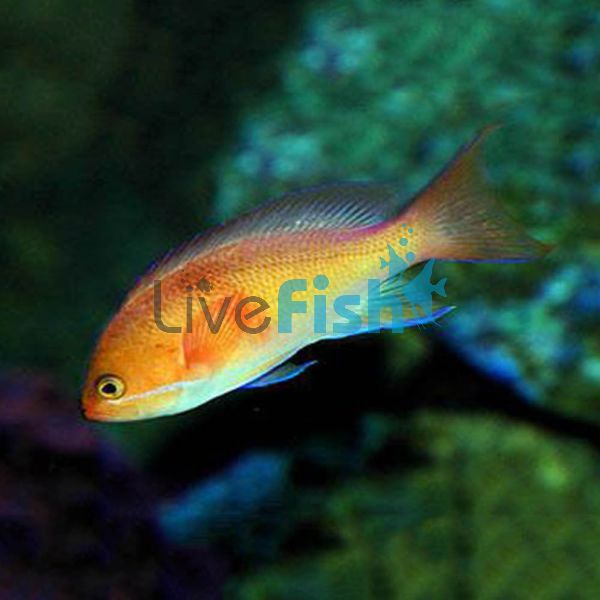Peach Anthias - Medium
The Peach Anthias looks great but can be susceptible to disease and difficult to feed when first introduced to an aquarium.
Peach Anthias
The Peach Anthias is a peaceful fish but may show aggression to other Anthias.
Male Anthias’ lower body is orange/red and the upper body is yellow, with a red dorsal fin. The females’ lower body is pale lavender/white with a yellow/orange upper body.
Peach Anthias are protogynous hermaphrodites. They are born female, with a small number of females (usually the largest) changing sex as they mature. If a dominant male is removed from a group, the largest female can change sex and replace it.
This species usually lives as a harem with a single male, sometimes a second subordinate male, and up to 12 females. Reproduction involves the male and female depositing their gametes into the water to fertilize the egg.
The natural environment for Peach Anthias is at depths of 1 to 18 meters, on steep outer reef slopes. They prefer areas with moderate currents where they can feed on zooplankton.
As Peach Anthias are a shoaling species it is recommended to have a least 4 in an aquarium, 6-8 is considered the optimum number.
Their natural habitat is in the Indo-Pacific, distributed across the Red Sea, Indonesia, Southern Japan, and Australia.
Tank Recommendations for the Peach Anthias
The smallest recommended tank size is 70 gallons (265 liters).
A suitable aquarium should have plenty of rocks and caves. There should be a strong water movement and open space for schooling.
Peach Anthias a capable of jumping out of the tank so a cover is recommended.
Suitable Tank Buddies
Best housed as part of a small group of conspecifics, the Peach Anthias is a peaceful fish but can show aggression to its own kind.
It may get harassed or bullied by damselfish and is also at risk of being eaten by bigger predatory fish.
Usually Compatible
Peach Anthias can co-habit with non-aggressive species such as Pygmy Angels, Basslets, Clownfish, and Cardinals.
Sometime Compatible
Care should be taken when housing Anthias with Lions/Scorpions, Batfish, Anglers/Frogfish, Triggers, Eels, and fish only Wrasse.
Rarely Compatible
Peach Anthias should not be housed with larger aggressive species such as Groupers or Sharks/Rays. Seahorse/Pipefish may be too delicate and outcompeted for food.
The Peach Anthias is a beautiful-looking fish. However, it does require more attention than other species and may suit more experienced aquarists.
Feeding Your Peach Anthias
Peach Anthias are carnivorous. In the wild, they consume zooplankton, which drifts in the currents around the reef.
In an aquarium, initially, they may be reluctant to eat. In this situation, commercially prepared zooplankton can encourage feeding.
Once they are established in a tank they can consume vitamin-enriched brine shrimp, frozen Mysis shrimp, and also small amounts of flake foods.
Live copepods and amphipods can be kept in an attached refugium and incorporated into Anthia's diet. Feeding is recommended several times a day.
| Scientific Name | Pseudanthias dispar |
|---|---|
| Care Level | Moderate |
| Common Names | Peach Anthias, Madder Seaperch, Peach Fairy Basslet, Redfin Anthias, Orange Anthias, Fancy Sea Bass |
| Diet | Carnivore |
| Fish Family | Serrinaidae |
| Lifespan (years) | 4 |
| Max. Length (cm) | 10 |
| Min. Tank Volume (l) | 265 |
| Origin | Indo-Pacific, distributed across the Red Sea, Indonesia, Southern Japan, and Australia |
| Reef Safe | Yes |
| Sociability | Peaceful |
| Water Conditions | 22-26° C, dKH 8-12, pH 8.1-8.4, sg 1.020-1.025 |



